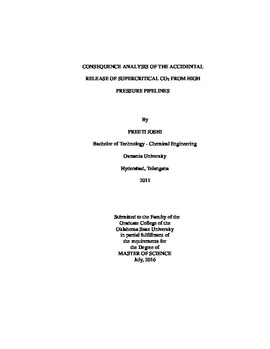| dc.contributor.advisor | Wang, Qingsheng | |
| dc.contributor.author | Joshi, Preeti | |
| dc.date.accessioned | 2017-02-22T22:15:20Z | |
| dc.date.available | 2017-02-22T22:15:20Z | |
| dc.date.issued | 2016-07-01 | |
| dc.identifier.uri | https://hdl.handle.net/11244/49095 | |
| dc.description.abstract | Climate change and global warming is a major challenge that we are facing today which involves the emission of harmful greenhouse gases into the atmosphere. CO2 is one of the primary greenhouse gases, among others, which is majorly as a result of anthropogenic emissions. Carbon capture and storage (CCS) is an integrated technology that prevents large amounts of CO2 from entering the atmosphere by capturing it from large point sources and safely sequestering them in geological storages. Safe transportation of the captured CO2 through long distance pipelines is a challenge that we face today due to the lack of technology to properly address the knowledge gap at various operating conditions. Pressurized pipelines are considered to be the most efficient and reliable way to transport CO2 due to the high density and low viscosity of CO2. Any accidental discharge from such high pressure pipelines may result in a significant damage to the ambient atmosphere and it also poses a dominant threat to human health. Therefore, transportation safety of CO2 should clearly be one of the most critical process design considerations in carbon-capture and storage (CCS) area. It is important to understand the unusual phase transition behavior of CO2 in order to model the fluid dynamics and subsequent atmospheric dispersion during such an accidental release. This thesis deals with a two-step approach for computing the final pollutant concentration. In the first step, the release rates of supercritical CO2 are calculated due to sudden decompression at the leak which may lead to chocked flow conditions. These release rates would serve as the key parameter in the second step, dispersion modeling, which determines the toxic concentration levels of CO2 at various downwind distances. Computational Fluid Dynamics software, Ansys Fluent 16.2 version is used for predicting the jet release rates and the concentration variations of pure CO2 over a given period of time and distance. The Fluent model has been validated against experimental work carried out by BP�s DF1 project at the Spadeadam site (UK) involving transient horizontal releases of supercritical CO2. A further investigation was carried out to study the impact of CO2 dispersion in the presence of obstacles such as buildings. This consequence model would not only be helpful to predict and control the harmful release of CO2 in ambient air, but would also serve as a hazard design tool for determining the minimum safe distances to populated areas and planning emergency response and evacuation procedures in case of pipeline leakage. | |
| dc.format | application/pdf | |
| dc.language | en_US | |
| dc.rights | Copyright is held by the author who has granted the Oklahoma State University Library the non-exclusive right to share this material in its institutional repository. Contact Digital Library Services at lib-dls@okstate.edu or 405-744-9161 for the permission policy on the use, reproduction or distribution of this material. | |
| dc.title | Consequence Analysis of the Accidental Release of Supercritical Co2 from High Pressure Pipelines | |
| dc.contributor.committeeMember | Bikkina, Dr. Prem | |
| dc.contributor.committeeMember | Aichele, Dr. Clint | |
| osu.filename | Joshi_okstate_0664M_14755.pdf | |
| osu.accesstype | Open Access | |
| dc.description.department | Chemical Engineering | |
| dc.type.genre | Thesis | |
| dc.type.material | text | |
